Everybody has occasionally glanced in the mirror and noticed a mark on their skin that wasn’t there the day before. These lesions, be they dark spots, blackheads, or pimples, frequently confuse. Is it pimples? Or just blemishes? It’s no secret that having healthy, radiant skin is something that everyone aspires to do. Even Google searches for “clear skin” methods are not uncommon, but the overwhelming amount of unreliable sources offering skincare advice simply serves to confuse the user. You can wind up doing more harm than good because you don’t know who to trust. Everybody knows how frustrating it is to wake up with unpleasant imperfections, feel uneasy, and be in an endless cycle of searching for a remedy. Throughout history, acne has been a recurring problem hurting the self-esteem and general well-being of both adults and teenagers.
What is Blemishes
Does your confidence go for a toss at the sight of a blemish? You are not alone. These skin flaws cause low self-esteem in many women. On the other hand, there are numerous ways to manage imperfections. You must first become conscious of your skin. Any kind of spot, discoloration, mark, or imperfection on the skin is called a blemish. Although the majority of blemishes are benign, some people may want to treat them for aesthetic purposes. Some imperfections might be signs of an underlying disease, such as skin cancer, that has to be treated right away.
What Are Types of Blemishes
1. Acne
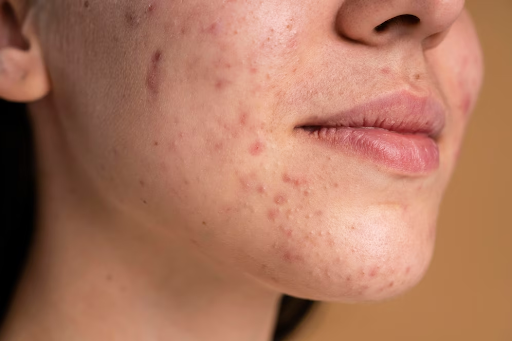 The overproduction of oil by the skin leads to the skin disorder known as acne. Excess oil production can be caused by a variety of circumstances, such as overactive oil glands; hormonal changes that occur during puberty, menstruation, or menopause; and hormone-altering conditions like stress, worry, or melancholy.
The overproduction of oil by the skin leads to the skin disorder known as acne. Excess oil production can be caused by a variety of circumstances, such as overactive oil glands; hormonal changes that occur during puberty, menstruation, or menopause; and hormone-altering conditions like stress, worry, or melancholy.
2. Hyperpigmentation
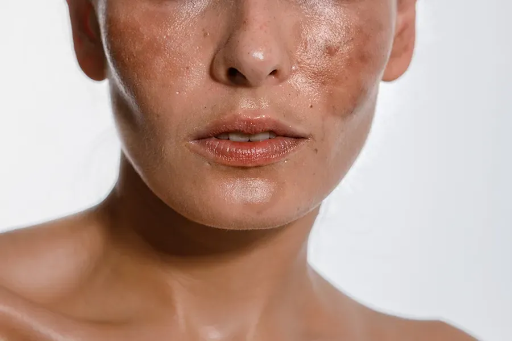
One kind of imperfection where the skin appears darker than in other places is called hyperpigmentation. It is typical and typically not harmful. Sun exposure, scarring from acne, and genetic factors can all lead to hyperpigmentation. The tendency to produce freckles is a form of hyperpigmentation that can be inherited. These are tiny, flat patches that can be black, tan, brown, or red. On the body, they can appear anywhere. Another form of hyperpigmentation is sunspots, sometimes known as “age spots.” These little dots or patches may appear on skin regions that receive a lot of sun exposure. After the acne has cleared up, black spots may still be present on the skin due to acne scarring.
3. Melasma
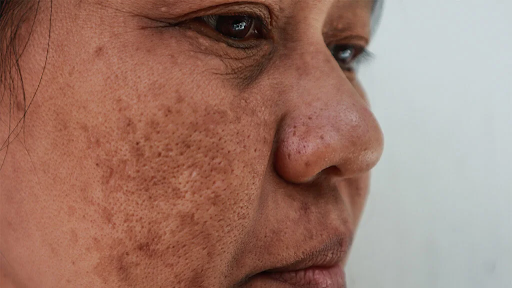
One form of hyperpigmentation that can appear during pregnancy or when taking birth control pills is called melasma.
Melanin levels rise as a result of the hormonal shifts that occur. The pigment called melanin is what gives skin its color. Skin might get darker due to melanin overproduction.
4. Ingrown hair
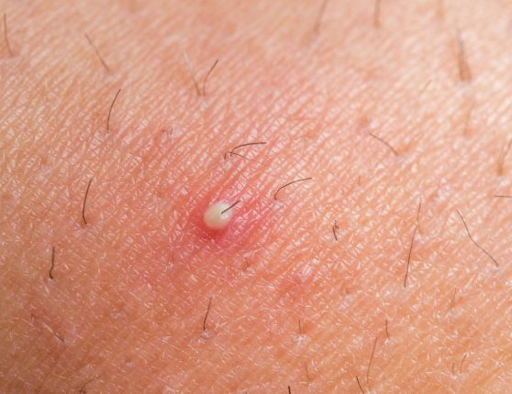
Occasionally, hairs may grow sideways into the skin or curl back on themselves, causing red, itching bumps to appear. These skin imperfections are known by doctors as ingrown hairs. Ingrown hairs can result from several hair removal methods, including shaving, plucking, and waxing.
5. Cold sores
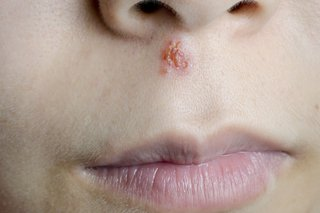
Cold sores are blisters that occur on the lips or around the mouth and are painful, red, and filled with fluid. They arise from the infection caused by the herpes simplex virus.
Since cold sores are extremely contagious, people should avoid close contact with others until the sores have healed in order to prevent the virus from spreading.
What Causes Blemishes
You must comprehend the causes of acne in order to comprehend why skin becomes blemished. Acne is caused by a mix of surface bacteria and lipids (fatty acids) from oil glands, as well as hormone sensitivity. Frequently, acne begins as a clogged pore and develops into pustules and papules as the bacteria grows. Blemishes can also result from the development of fungal acne, which is an overabundance of yeast in the hair follicles.
How to Manage Blemishes
Now that you are aware of what acne-prone skin looks like and the causes of blemishes, let’s discover how to treat these bothersome spots, lessen their visibility, and eventually avoid them!
1. Get a facial scrub
Using a face scrub is the initial step to skin repair, regardless of the kind of blemishes or pimples you’re struggling with. Pay attention to your skin when exfoliating! Exfoliators are safe for some people to use every day, while others with sensitive skin might only need to use them once or twice a week.
2. Use products with Benzoyl Peroxide
Blemishes can be removed with benzoyl peroxide’s antibacterial properties. Get your hands on one of these items to maintain the best possible condition for your skin. It is frequently found in creams, gels, and cleansers.
3. Avoid picking blemishes
Try, as difficult as it may be, to limit the amount of time you touch your face when fixing blemishes. Bacteria may spread as a result, making your current imperfections worse and preventing new ones from appearing.
How to Prevent Blemishes
1. Maintain an effective skincare routine
For a skincare regimen to combat blemishes, consistency is essential. Although we all wish for spots to go instantly, achieving a clearer skin requires persistence, time, and daily use of the appropriate products. Thus, you shouldn’t give up on a formula simply because it doesn’t work right away. Changing up your products too frequently might make a breakout worse. To notice results, try a new routine for at least 30 days. At that point, evaluate your skin’s condition to determine what is (and is not) working.
2. Remove makeup before going to sleep
If there is one skincare tip you should follow every day, it is to always remove your makeup before going to bed. If you go to bed wearing foundation or concealer, your pores will get clogged and you’ll have more imperfections. Include double cleansing in your evening regimen to effectively get rid of bacteria that cause spots on your skin.
3. Avoid touching your skin or face
Avoid touching your skin unless you are applying sunscreen or rubbing in moisturizer, as this will transfer additional bacteria to your face. The same is true for squeezing spots; instead, let your skincare regimen handle them. If not, you risk pushing the infection more into the pores, which will impede healing and increase the likelihood of scarring.
4. Maintain hydration on your skin
After cleansing, always use a skin softener and moisturizer to hydrate your pores since your skin needs the proper balance of moisture and purity to regulate sebum production. Drink water throughout the day to stay hydrated from the inside out as well. Always carry a bottle of water with you to ensure that you never forget to take a sip when you’re thirsty.
Acne, age spots, and birthmarks are a few types of facial blemishes. Depending on the cause, a variety of treatment options are available to you. Sometimes, a doctor visit may be required to assess your facial blemish. You may consult a doctor at Theme Dermatology to solve your problems.
Why Choose Gangnam Theme Dermatology
Although anyone can get blemishes at any time, people with oily or extremely dry skin are more prone to breakouts because of unbalanced sebum glands. Spots can emerge in your twenties, thirties, and even following menopause, so it’s not simply a youthful problem. Because of this, it’s essential to take care of your skin at every stage of life by washing and moisturizing it frequently. Beyond just being dark patches on your face, blemishes come in a variety of forms, which this article should have clarified for you. Feel free to contact Theme Dermatology Clinic to have a consultation with your skin condition.
With three board-certified dermatologists with extensive expertise, Gangnam Theme Dermatology is one of the oldest dermatology practices in Gangnam, Seoul, South Korea. It can be found right between Sinnonhyeon and Gangnam Stations, in the center of the famous Gangnam neighborhood. With an extensive experience of over 20 years in dermatology, our team of specialists is highly regarded for their expertise and unwavering commitment to excellence. Over more than 20 years, the clinic cared for patients with various skin issues and types. They can assist you with acne, pigmentation, anti-aging (lifting), scars, and other skin issues. Also, among Korean clients, they are one of the most well-known skin clinics. The variety of services they offer and their knowledge of skin issues will satisfy you.
Gangnam Theme Dermatology Booking Information
The clinic can be found at 423 Gangnam-daero, Seocho-gu, Hanseung Building, 7th Floor, Seoul, South Korea. To reach out directly, dial +821094839974 on WhatsApp and Kakao. Sending a message to Gangnam Theme Dermatology will allow you to talk about your concerns, make an appointment, or receive an online consultation. Send an email to [email protected]. You can also look through everything and ask questions on the Gangnam Theme Dermatology website by clicking this link: About Us


FAQs
A blemish is any kind of mark or discoloration on the skin, but acne is a specific skin ailment brought on by clogged pores.
Acne is quite prevalent. According to some studies, almost everyone experiences pimples at some point in their lives. Although they are more prevalent in puberty, adults can still experience them.
You cannot spread pimples. There is no way for skin-to-skin contact to transfer them to another individual.
Conclusion
The majority of us dreamed of having radiant skin upon awakening each morning. Perhaps that moment will come very soon. It’s important to remember that getting clear skin takes time. Everything is dependent upon you, your way of life, and the amount of work you are prepared to put in to get clear skin. Continue following your skincare treatments, change your bedding regularly, store a separate towel for your body and face after washing, and consistently consume foods that are considered to be healthy. Your questions on “What are the types of blemishes” and “How can I get rid of them” should have been addressed in this comprehensive article. So feel free to contact our dermatologists for skin problem treatment.

